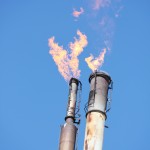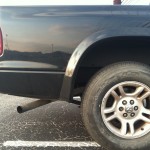When Hazardous Waste Lived Right Down the Street

Photo by Teresa Vieira/KUT News
The closed entrance to the former Encycle plant in Corpus Christi, Texas
What would it be like to grow up down the street — literally a block away — from a plant that treats hazardous waste? For the residents of the Dona Park neighborhood in Corpus Christi, this isn’t a hypothetical question. For fourteen years, the Encycle plant treated hazardous waste just 950 feet away from the neighborhood, which is also surrounded by six major refineries.
As you can see from the map below, the Encycle plant sits right at the edge of four long residential blocks, consisting of nearly three hundred homes. The plant is now being demolished, but families in Dona Park worry that as it’s being torn down, it could pollute the neighborhood again.
View Dona Park in a larger map
A Toxic History
The Encycle facility was originally an American Smelting and Refining Company (ASARCO) plant that smelted zinc. It was built in 1941, a few years before the Dona Park neighborhood was established. It smelted zinc until 1985. Its smokestack, 315 feet high and wrapped in asbestos, still towers over the community. “The stack blew everything in to the neighborhood,” recalls Tammy Foster, who has lived in Dona Park nearly all her life. “It would literally go up like a huge cloud and just fall. I remember riding my bike through there and it would be settling over the top of the neighborhood. You could watch it actually come down.”
On the Texas Commission on Environmental Quality’s (TCEQ) website about cleanups in Dona Park, it says that while the zinc smelter was running, it “was a potential source of zinc, cadmium and lead contamination from the facility via wind dispersion in the residential area.”
Hazardous Waste Moves In

Photo by Teresa Vieira/KUT News
A falling building at the former ASARCO/Encycle plant. The TCEQ considers the transparent screen on the fence as protection for local residents from wayward metals and dust.
In 1988, ASARCO changed things up at the 108-acre site. The company turned the plant over to a wholly-owned subsidiary, Encycle, which was permitted to process hazardous waste there.
In 1999, the Encycle operation was found to be violating its permits. “They were supposedly recycling hazardous wastes and they found out they weren’t recycling,” says Kelly Haragan, director of the Environmental Law Clinic at the University of Texas. “They were just mishandling all these hazardous wastes.” Encycle stopped operating a few years later in 2003 and completely shut down in 2005, when its parent company, ASARCO, filed for bankruptcy and left the plant. “This is one of their sites that’s seriously contaminated,” says Haragan. “It’s got a lot of metals.”
Corpus Christi wasn’t the only place where ASARCO was found to be violating rules. Near one of the company’s lead smelters in El Paso, studies found children had “levels of lead in their blood four times today’s acceptable limit,” according to an NPR report. The company stopped lead smelting at that plant as a result. Today ASARCO is known as one of the country’s worst polluters. When the company finally settled its bankruptcy last year, it paid out $1.79 billion in settlements for pollution at 80 sites across the country.
Dona Park residents have been asking themselves ever since the hazardous waste plant here closed in 2005: What’s left in that plant? And is it doing anything to me and my family?
Testing the Neighborhood

Photo by Teresa Vieira/KUT News
Dona Park resident Billy Placker shows results of test that found high levels of Arsenic in his blood
Though there had been various cleanups in Dona Park since the mid-nineties, after the Encycle plant closed residents voiced concerns about potential heavy metals and contaminants in the soil of their yards. This year, the TCEQ conducted a soil sampling study. 478 yards were tested, and the commission reported that out of all of those “only five yards had COC concentraions above the action levels for lead and/or cadmium only.” None of the yards tested high for mercury, and the TCEQ scraped away the five yards where they found lead and cadmium, replacing the topsoil.
A map of yards “remediated” by the TCEQ. The Asarco/Encycle plant sits just north of Up River road:
“Based on the entire data set collected for Dona Park,” TCEQ spokesperson Terry Clawson told StateImpact Texas in an email, “the TCEQ has concluded that the neighborhood has been adequately assessed and all environmental issues requiring action have been addressed.” (Read the full TCEQ soil sampling study of Dona Park.)
Environmental lawyer Kelly Haragan, who works with many of the residents in Dona Park, says that the TCEQ has come in at least three times since 2005 to clean up yards contaminated with metals. “People in the community aren’t very trusting of that process, because they keep doing it, and then coming back and finding more, and having to do it again,” she says. “So I don’t know whether it’s not getting cleaned up very well when it is cleaned up, or if it’s getting re-contaminated.”
Last week the Texas Department of State Health Services presented the results of a blood and urine study they conducted of residents in Dona Park this year. They looked for higher than normal levels of arsenic, cadmium, lead or mercury. “We didn’t find any unusual exposure to these contaminants,” says Dr. Carrie Bradford, a toxicologist at the department who led the study. Dr. Bradford also noted that the “purpose of this [study] was not to determine the source of any kind of exposure, just these are what the results are.” (Read the results of the study and Dr. Bradford’s presentation to Dona Park residents.)
“We came out to offer free screenings for people concerned,” Dr. Bradford says. “Most of the levels were low. Because metals are so common we’d expect to see some of the metals.” But the study found very few levels that were above normal, and those who did test high initially later tested in the normal range.Residents here maintain that the plant and numerous surrounding refineries have caused numerous health problems in the small neighborhood. “There’s a lot of birth defects, learning disabilities caused by the lead,” says longtime resident Tammy Foster. “You’ve got kids born with no ear, miscarriages, cancer, Alzeheimer’s, mysterious tumors on pets. Just all kinds of bizarre things.”
Finding direct links between the ASARCO plant and operating refineries and health effects in the community has been difficult. “If you go in these communities and talk to people, people are sick. Something’s going on,” says UT environmental attorney Kelly Haragan. “The problem is the state of the science just isn’t there to actually trace, okay, what’s causing this problem, is this emission from this plant?” Haragan says they have similar issues tying exposures to toxins and metals in the neighborhood to specific cases of cancer in the community.
Nearly a Decade After Closing, Still a Threat?
As the plant is now being demolished, residents worry that toxins and chemicals inside the plant are being spread through the neighborhood again. “That stuff has been blowing across the neighborhood for a long time,” says resident Billy Placker. “Now they’re tearing it down, and it’s blowing across [the neighborhood] again.”
The absetos-wrapped stack towering over Dona Park may be gone by early 2012. The cleanup project is estimated to cost around $12 million, with about $10 million of that coming from Encycle and ASARCO’s bankruptcy. The rest will come from the TCEQ. “There’s a lot of concern that in tearing that stuff down, you’re going to get more emissions in the community,” Kelly Haragan, an environmental attorney, says. “So the EPA and TCEQ are monitoring around the site, but I think people don’t really trust that there’s not going to be more contamination.”
The TCEQ’s spokesperson, Terry Clawson, says that they agency is adequately monitoring the demoliton of the plant. “The TCEQ has a contractor who performs site visits to observe the status of work and the ongoing activities,” he says.
On the commission’s website, weekly reports are available to the public about the demolition and monitoring of air during the project. One can see from the reports when work gets stopped due to winds picking up and heading towards Dona Park, and when work is stopped due to high particulate levels. The TCEQ is also doing air sampling for metals and asbestos, both through lab testing and real-time monitoring of particulates in the air. The concern is that if winds pick up during demolition, these metals and particulates could spread through the neighborhood.
What Happens Next
Residents and environmental activists aren’t assuaged by the health study results or TCEQ’s demolition work. They want to shut the neighborhood down for good and establish a green “buffer zone” between residential areas and the old ASARCO plant and operating refineries. “We know that there’s emissions coming out these plants that are dangerous. And we know that there’s chemicals that are stored on site that are dangerous, and if there was an accident would kill people in the community,” says Kelly Haragan, director of the Environmental Law Clinic at the University of Texas Austin. As the port of Corpus Christi continues to grow, even if regulations become tighter, the amount of emissions may still increase. “I don’t think it’s going to get better for these communities any time soon,” Haragan says. “I think it’s only going to get worse.”
Tomorrow, November 18, Corpus Christi is co-hosting an environmental summit for the community with the EPA. “The whole point of it was to convene, to bring everyone to the table to discuss buyouts,” Tammy Foster says. “That was the focus of the meeting. It’s turned into something else, but we still have buyouts on the table. So we’re hoping that all of us getting together and talking to industry reps, having everyone at one table, will motivate them to do something.”




